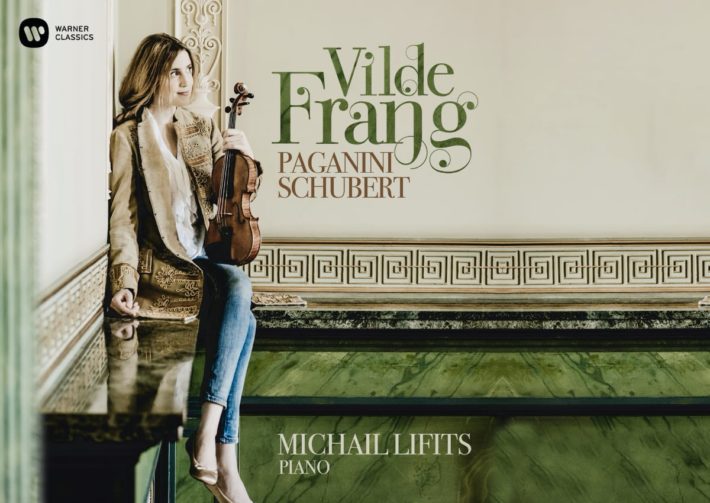In a relatively short time, violinist Vilde Frang has established herself with an impressive résumé of acclaimed recordings for Warner Classics. Ranging from concertos of Mozart to Prokofiev and Britten, her repertoire is comprehensive. No stranger to chamber music, her recordings have included a selection of romantic sonatas, with her partner on this latest release — pianist Michail Lifits. This release focusses on two very different composers who are not natural bedfellows — Schubert and Paganini. In the booklet, Frang eloquently illustrates Paganini’s influence on Schubert, explaining the programming and overall approach.
Frang’s performances on this album are as diverse as the two composers. Opening the album with virtuosic panache, Frang begins with Paganini’s tour de force for solo violin, the “Introduction & Variations on ‘Nel cor più non mi sento’ by Paisiello”, a showpiece for her formidable technique. Her approach is completely intrinsic to the style, excels in the showmanship of the piece, and emphasizes the timbres and textures with effortless ease and spontaneity. Frang brings a sense of drama with an uncompromising technical assurance, in a performance with absolute musical conviction, as she does in the albums’s concluding work, Ernst’s “Grand Caprice sur ‘Le Roi des Aulnes’ (Op.26). The same is true for the rest of the post-Schubert pieces in this program, where the two musicians find operatic drama and a sense of fun.
Virtuosity aside, at the heart of the recital are two substantial works of Schubert, the “Fantasy in C” (D.394”) and the “Rondo in B minor (D.895). Joining a long list of Herculean interpreters of Schubert’s relatively small catalog of works for violin and piano, Frang’s interpretations stand alongside violinists such as Julia Fischer, Tasmin Little, Isabella Faust and Alina Ibragimova. The opening movement of the “Fantasy” lacks Frang’s beautiful tone otherwise found in her Sibelius or Korngold violin concerto recordings. Her sound disappoints and Lifits’ accompaniment is rather too overwhelming. The performance lacks the naturalness of Fischer with Martin Helmchen —who’s accompaniment floats effortlessly, or the magic of Faust and Alexander Melnikov. There is also very little uniformity to Frang and Lifits’ phrasing, sense of direction and purpose in the Andantino. While each instrumentalist’s approach is acceptable, together they are sadly incompatible, compounded by the literal interpretation of dynamics. This often distracts from their technical abilities. Lifits is far more refined, understanding the more fragile side of Schubert; Frang makes the more technical passages sound akin to Paganini, resulting in an awkward incompatibility. Faust and Melnikov are more restrained here, while Fischer finds a more vocal way to approach the phrasing. Frang is faithful to Schubert’s tempo and time signatures in the finale, marked “allegro vivace”, but lacks the restraint needed to make this movement completely convincing, unlike Faust’s overall refined rendition.
Related Classical Music Reviews
- Review: Beethoven And Sibelius Violin Concertos – Christian Tetzlaff
- Review: Schubert – Symphony No. 9 (“The Great”) – Scottish Chamber Orchestra – Emelyanychev
- Mendelssohn – Violin Concerto – The Best Recordings (Part One)
Frang’s Rondo D.895 is almost identical, timing-wise, to Tasmin Little’s. while Frang’s is well-paced, the musical peaks are frequently overly-grand rather than modestly restrained. Little’s tone is richer and sweeter than Frang’s slightly astringent quality, while Faust’s faster rendition has greater light and shade in a more restrictive dynamic range, increasing the emotional intensity. Fischer’s architectural phrasing projects the structure and sense of space most clearly.
The recorded sound and balance are excellent throughout. Warner’s engineers have diligently produced a recording with a purity of sound from both violin and piano. The acoustic of Teldex Studio, Berlin, creates an enhanced reverberance with a more balanced sound than on either Fischer or Faust’s albums.
Frang is faultless technically, with impeccable rhythmic accuracy and pristine intonation, an overall style that is more suited to the Paganini pieces. Lifits is the stronger interpreter of Schubert, finding greater beauty in this composer’s introspective music, knowing how to pace the harmonic peaks and intricacies. His solo passages shine throughout — as in the Andantino of the Fantasie (track 4). There is some musical bond between the musicians, however Frang here takes an extrovert role, with extravagant musical gestures which are too grand for Schubert’s more refined musical language.

Works by Schubert and Paganini for violin and piano
Vilde Frang – Violin
Michail Lifits – Piano
Warner Classics, CD 0190295419363
Albums Mentioned In This Review
Read more classical music reviews or visit The Classic Review Amazon store
Follow Us and Comment:
Get our periodic classical music newsletter with our recent reviews, news and beginners guides.
We respect your privacy.








